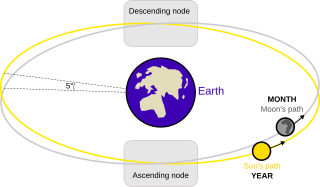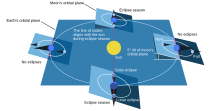Lunar node
This article includes a list of generalreferences,butit lacks sufficient correspondinginline citations.(January 2018) |

Alunar nodeis either of the twoorbital nodesof theMoon,that is, the two points at which theorbit of the Moonintersectstheecliptic.Theascending(ornorth) node is where the Moon moves into the northernecliptic hemisphere,while thedescending(orsouth) node is where the Moon enters the southern ecliptic hemisphere.
Motion[edit]
Theline of nodes,which is also the intersection between the two respective planes, rotates (precesses) with a period of 18.6 years or 19.5°/year or 19.1 days/year. When viewed from the celestial north, the nodes move clockwise around Earth, I.e. with aretrograde motion(opposite to Earth's own spin and its revolution around the Sun). So the time from one node crossing to the next (seeeclipse season) is approximately a half-year less half of 19.1 days -- or about 173 days.
Because theorbital planeof the Moonprecessesin space, the lunar nodesalso precessaround the ecliptic, completing one revolution (called adraconic periodornodal period) in 18.612958 years (6,798.383 days). (This is not the same as asarosof 18.03 years) The same cycle measured against an inertial frame of reference, such asInternational Celestial Reference System(ICRS), acoordinate systemrelative to thefixed stars,is 18.599525 years.
Eclipses[edit]

Alunar eclipsecan occur only when thefull Moonis near either lunar node (within 11° 38' ecliptic longitude), while asolar eclipsecan occur only when thenew Moonis near either lunar node (within 17° 25').
Both solar eclipses of July 2000 (on the1stand31stdays) occurred around the time when the Moon was at its ascending node. Ascending-node eclipses recur after onedraconic yearon average, which is about 0.94901Gregorian year,as do descending-node eclipses.
AnEclipseof the Moon or Sun can occur when the nodes align with the Sun, roughly every 173.3 days. Lunar orbit inclination also determines eclipses; shadows cross when nodes coincide with full and new moon when the Sun, Earth, and Moon align in three dimensions.
In effect, this means that the "tropical year"on the Moon is only 347 days long. This is called thedraconic year(oreclipse year). The "seasons" on the Moon fit into this period. For about half of this draconic year, the Sun is north of the lunar equator (but at most 1.543°), and for the other half, it is south of the lunar equator. Obviously, the effect of these seasons is minor compared to the difference between lunar night and lunar day. At the lunar poles, instead of usual lunar days and nights of about 15 Earth days, the Sun will be "up" for 173 days as it will be "down"; polar sunrise and sunset takes 18 days each year. "Up" here means that the centre of the Sun is above the horizon. Lunar polar sunrises and sunsets occur around the time of eclipses (solar or lunar). For example, at theSolar eclipse of March 9, 2016,the Moon was near its descending node, and the Sun was near the point in the sky where the equator of the Moon crosses the ecliptic. When the Sun reaches that point, the center of the Sun sets at the lunar north pole and rises at the lunar south pole.
Names and symbols[edit]

The nodes are called by different names in different cultures of the world.
In medievalArabictexts, alongside the sevenclassical planets,it was believed that an eighth pseudo-planet was the cause of solar and lunar eclipses, termedal-Tinnīn(the Dragon) oral-Jawzahr(fromClassical PersianGawzahr).[1]The planet was split into two parts representing the lunar nodes, termed the Head (ra’s) and Tail (dhanab) of the mythological dragon.[2]Similarly, the nodes are termedrosh ha-teli u-zenavo(ראש התליוזנבו)[verification needed]inHebrew,andcaput draconis(head of the dragon) orcauda draconis(tail of the dragon) inLatin.[3]The ascending node is referred to as thedragon's headwith theastronomicalorastrologicalsymbol of ☊ and the descending node is known as thedragon's tailwith the symbol ☋.
InHindu astronomy,the nodes are considered with theseven planetsamong the nineNavagrahas;the ascending node ☊ is calledRahuand the descending node ☋ is calledKetu.[4]InTibetan astrology(partially based on theKalachakra Tantra) these nodes are respectively namedRahuandKalagni.[5]
Extremes[edit]
Inclination extremes[edit]
Every 18.6 years, the angle between the Moon's orbit and Earth'sequatorreaches a maximum of 28°36′, the sum of Earth'sequatorial tilt(23°27′) and the Moon'sorbital inclination(5°09′) to theecliptic.This is calledmajorlunar standstill.Around this time, the Moon'sdeclinationwill vary from −28°36′ to +28°36′. Conversely, 9.3 years later, the angle between the Moon's orbit and Earth's equator reaches its minimum of 18°20′. This is called aminor lunar standstill.The last lunar standstill was a minor standstill in October 2015. At that time the descending node was lined up with the equinox (the point in the sky havingright ascensionzero anddeclinationzero). The nodes are moving west by about 19° per year. The Sun crosses a given node about 20 days earlier each year.
When the inclination of the Moon's orbit to the Earth's equator is at its minimum of 18°20′, the centre of the Moon's disk will be above thehorizonevery day from latitudes less than 70°43' (90° − 18°20' – 57' parallax) north or south. When the inclination is at its maximum of 28°36', the centre of the Moon's disk will be above the horizon every day only from latitudes less than 60°27' (90° − 28°36' – 57' parallax) north or south.
Athigher latitudes,there will be a period of at least one day each month when the Moon does not rise, but there will also be a period of at least one day each month when the Moon does not set. This is similar to theseasonalbehaviour of the Sun, but with a period of 27.2 days instead of 365 days. Note that a point on the Moon can actually be visible when it is about 34arc minutesbelow the horizon, due toatmospheric refraction.
Because of the inclination of the Moon's orbit with respect to the Earth's equator, the Moon is above the horizon at theNorthandSouth Polefor almost two weeks every month, even though the Sun is below the horizon for six months at a time. The period from moonrise to moonrise at the poles is atropical month,about 27.3 days, quite close to the sidereal period. When the Sun is the furthest below the horizon (winter solstice), the Moon will be full when it is at its highest point. When the Moon is inGeminiit will be above the horizon at the North Pole, and when it is inSagittariusit will be up at the South Pole.
The Moon's light is used byzooplanktonin the Arctic when the Sun is below the horizon for months and must have been helpful to the animals that lived in Arctic and Antarctic regions when the climate was warmer.
Declination extremes[edit]
The Moon's orbit is inclined about 5.14° to theecliptic;hence, the Moon can be up to about 5° north or south of the ecliptic. The ecliptic is inclined about 23.44° to thecelestial equator,whose plane isperpendicularto the rotational axis of Earth. As a result, once during the 18.6-year nodal period (when the ascending node of the Moon's orbit coincides with thevernal equinox), the Moon'sdeclinationreaches a maximum and minimum (northern and southern extremes): about 28.6° from the celestial equator. Therefore, the moonrise or moonsetazimuthhas its northern- and southernmost points on the horizon; the Moon atculminationhas its lowest and highestaltitude(when the body transits themeridian); and first sightings of thenew moonpotentially have their latest times. Furthermore,occultationsby the Moon of thePleiadesstar cluster, which is over 4° north of the ecliptic, occur during a comparatively brief period once every nodal period.
Effect on tides[edit]
Theprecessionof the lunar nodes has a small effect on Earth'stides–atmospheric,oceanic,orcrustal.[6][7] The U.S.National Oceanic and Atmospheric Administration(NOAA) determinesmean lower low water(MLLW) at a location by averaging the height of the lowest tide recorded at that location each day during a 19-year recording period, known as the National Tidal Datum Epoch.[8]The 19-year recording period is the nearest full-year count to the 18.6-year cycle of the lunar nodes.[9]
In conjunction withsea level risecaused byglobal warming,lunar nodal precession is predicted to contribute to a rapid rise in the frequency ofcoastal floodingthroughout the 2030s.[10]
See also[edit]
References[edit]
- ^Azarpay, G.; Kilmer, A. D. (1978). "The Eclipse Dragon on an Arabic Frontispiece-Miniature".Journal of the American Oriental Society.98(4): 363–374.doi:10.2307/599748.JSTOR599748.
- ^Carboni, Stefano (1997).Following the Stars: Images of the Zodiac in Islamic Art.New York: The Metropolitan Museum of Art. p. 23.
- ^Sela, Shlomo (2003),Abraham Ibn Ezra and the Rise of Medieval Hebrew Science,Brill's Series in Jewish Studies, vol. 32, Leiden / Boston: Brill, pp. 124–126, 244–245,ISBN9789004129733
- ^Hartner, Willy(1938), "The Pseudoplanetary Nodes of the Moon's Orbit in Hindu and Islamic Iconographies: A Contribution to the History of Ancient and Medieval Astrology",Ars Islamica,5(2): 112–154,JSTOR4520926
- ^Berzin, Alexander(1987), "An Introduction to Tibetan Astronomy and Astrology",The Tibet Journal,12(1): 17–28,JSTOR43300228
- ^Godin, G. (2015). The Use of Nodal Corrections in the Calculation of Harmonic Constants. The International Hydrographic Review, 63(2). Retrieved fromhttps://journals.lib.unb.ca/index.php/ihr/article/view/23428
- ^Kaye, Clifford A.; Stuckey, Gary W. (1973). "Nodal Tidal Cycle of 18.6 Yr.: Its Importance in Sea-Level Curves of the East Coast of the United States and Its Value in Explaining Long-Term Sea-Level Changes".Geology.1(3): 141.Bibcode:1973Geo.....1..141K.doi:10.1130/0091-7613(1973)1<141:NTCOYI>2.0.CO;2.ISSN0091-7613.
- ^"Tidal Datums".Tides and Currents.NOAA.
- ^"Tidal Datums and Their Applications"(PDF).Tides and Currents.Silver Spring, Maryland:NOAA(Special Publication NOS CO-OPS 1). June 2000.
- ^Thompson, Philip R.; Widlansky, Matthew J.; Hamlington, Benjamin D.; Merrifield, Mark A.; Marra, John J.; Mitchum, Gary T.; Sweet, William (July 2021)."Rapid increases and extreme months in projections of United States high-tide flooding".Nature Climate Change.11(7): 584–590.Bibcode:2021NatCC..11..584T.doi:10.1038/s41558-021-01077-8.ISSN1758-678X.S2CID235497055.
External links[edit]
- Sun and Moon Polar Applet,showing moonrise/moonset azimuths
- Astronomy Answers:What are the standstills of the Moon? Retrieved 2016-08-26.
- Eclipses, Cosmic Clockwork of the Ancients
- Lunar and solar periods,about inertial frame of reference for measuring movements of celestial bodies.
- Mean lunar and solar periods
